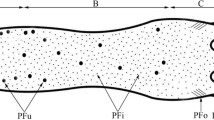Synopsis
The lingual glands of amphibians are confined to the dorsal face of the tongue and are formed by invaginations of the lingual epithelium. The secretory products have a heterogeneous composition. Mucosubstances are usually associated with proteins. The secretory product of the outer glandular cells is rich in mucosubstances of an acidity varying with species. In Anourans and Urodeles, the secretory product of the tubes contains abundant proteins and, where present, mucosubstances are less abundant and less acid than those produced at the surface of the tongue. Proteins and mucosubstances coexist in the same secretory granules, which exhibit a more or less homogeneous appearence in Gymnophiona and in Anourans while having a complex structure in Urodeles.
In spite of their primitive anatomical features, the amphibian lingual glands present histochemical signs of a complete cellular evolution.
Similar content being viewed by others
References
Adams, C. W. M. (1956). A stricter interpretation of the ferric ferricyanide reaction with particular reference to the demonstration of the protein-bound sulphydryl and disulphid groups.J. Histochem. Cytochem. 4, 23–35.
Albanese Carmignani, M. P. &Zaccone, G. (1974). Mucopolysaccharide histochemistry of the lingual glands inDiscoglossus pictus Otth. (Anoun, Amphibian).Ann. Histochim. 19, 47–63.
Albanese Carmignani, M. P., Zaccone, G. &Cannata, F. (1975). Histochemical studies on the tongue of Anourans Amphibian: I. Mucopolysaccharide histochemistry of the papillae and lingual glands inHyla arborea L.,Rana esculenta L. andBufo vulgaris Laur.Ann. Histochim. 20, 47–65.
Barrnett, R.-J. &Seligman, A.-M. (1952). Histochemical demonstration of protein-bound sulphydryl groups.Science 116, 323–7.
Fahrenholz, C. (1937). Drüsen der Mundhöle.Hdbch. Vergl. Anatomie Wirbeltiere (L. Bolck, E. Göppert, E. Kallius & W. Lubosch)3, 115–210.
Fährmann, W. V. (1975). Vergleichende Untersuchungen an den Sekretgrana der Zungendrüsen verschiedenerTriturus-Arten.Zool. Jb. 94, 346–57.
Francis, E. T. B. (1961). The source and the nature of salivary secretions in Amphibia.Proc. zool. Soc. 136, 453–76.
Gabe, M. (1968). Techniques histologiques. Paris: Masson.
Gabe M. (1971). Apport de l'histologie à l'étude des relations phylétiques des Gymnophiones.Bull. biol. 105, 125–57.
Gabe, M. &Martoja, M. (1956). Rôle du facteur temps dans l'acétylation réversible suivant McManus et Cason.Ann. Histochim. 1, 181–90.
Gabe, M. &Saint Girons, H. (1969). Données histologiques sur les glandes salivaires des Lépidosauriens.Mém. Mus. natn. Hist. nat. 58, 1–112.
Lison, L. (1960).Histochimie et Cytologie animale, 3d Edn. Paris: Gauthiers-Villars.
Mcmanus, J. F. A. (1946). The histochemical demonstration of mucus after periodic acid.Nature 158, 202.
Monneron, A. &Bernhard W. (1966). Action de certaines enzymes sur des tissus inclus en Epon.J. Microsc. 5, 697–714.
Mowry, R. W. (1956). Alcian blue technics for histochemical study of acidic carbohydrates.J. Histochem. Cytochem. 4, 407–8.
Mowry, R. W. (1963). The specific value of methods that color both acidic and vicinal hydroxyl groups in the histochemical studies of mucins. With revised directions for colloidal iron stain, the use of alcian blue G8X and their combination with periodic acid-Schiff reaction.Ann. N. Y. Acad. Sci. 106, 402–23.
Navalade, M. N. &Varute, A. T. (1971). Histochemical studies on the mucins of the Vertebrate tongues. I. Histochemical analysis of mucosubstances in the amphibian tongue.Histochem. 27, 351–65.
Navalade, M. N. &Varute, A. T. (1972). Histochemical studies on the mucins of the Vertebrate tongue. II. Mucopolysaccharides in cells of taste buds in the tongue of tadpoles ofRana tigrina andBufo melanosticus.Acta histochem. 43, 202–10.
Özeti, N. &Wake, D. B. (1969). The morphology and the evolution of the tongue and associated structures in salamanders and newts (family Salamandridae).Copeia 1, 91–123.
Pearse, A. G. E. (1968).Histochemistry, 3rd Edn. Boston: Little Brown and Co.
Ravetto, C. (1964). Alcian blue-alcian yellow. A new method for the identification of different acidic groups.J. Histochem. Cytochem. 12, 44–5.
Spicer, S. S. &Meyer, D. B. (1960). Histochemical differentiation of acid mucopolysaccharides by means of combined aldehyde fuchsin-alcian blue staining.Am. J. clin. Path. 33, 453–60.
Thiery, J. P. (1967). Mise en évidence des polysaccharides sur coupes fines en microscopie électronique.J. Microscopie 6, 987–1018.
Yasuma, A. &Ichikawa, T. (1953). Ninhydrin-Schiff and alloxan-Schiff stainingJ. Lab. clin. Med. 41, 296–9.
Zylberberg, L. (1972). Données histologiques sur les glandes linguales d'Ichthyophis glutinosus L. (Batracian, Gymnophione).Archs Anat. microsc. Morph. exp. 61, 227–42.
Zylberberg, L. (1973). Données histologiques sur les glandes linguales de quelques Salamandridés (Batraciens, Urodèles).Archs Biol. 84, 341–66.
Zylberberg, L. (1976). Données histologiques sur les glandes linguales de quelques Batraciens Anoures.J. biol. bucc. 4, 237–59.
Author information
Authors and Affiliations
Rights and permissions
About this article
Cite this article
Zylberberg, L. Histochemistry and ultrastructure of amphibian lingual glands and phylogenetic relations. Histochem J 9, 505–520 (1977). https://doi.org/10.1007/BF01002979
Received:
Revised:
Issue Date:
DOI: https://doi.org/10.1007/BF01002979




